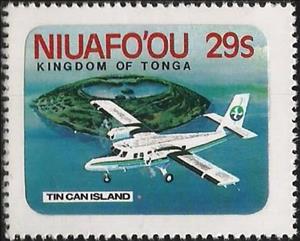Stamp: Opening of the airport (Niuafo'ou 1983)
Opening of the airport (Niuafo'ou 1983)
11 May (Niuafo'ou ) within release Opening of the airport goes into circulation Stamp Opening of the airport face value 29 Tongan seniti
| Stamp Opening of the airport in catalogues | |
|---|---|
| Michel: | Mi: TO-NI 1 |
Stamp is square format.
Also in the issue Opening of the airport:
- Stamp - Opening of the airport face value 29;
- Stamp - Opening of the airport face value 1;
Stamp Opening of the airport it reflects the thematic directions:
An aircraft (pl. aircraft) is a vehicle that is able to fly by gaining support from the air. It counters the force of gravity by using either static lift or the dynamic lift of an airfoil, or, in a few cases, direct downward thrust from its engines. Common examples of aircraft include airplanes, rotorcraft (including helicopters), airships (including blimps), gliders, paramotors, and hot air balloons.Part 1 (Definitions and Abbreviations) of Subchapter A of Chapter I of Title 14 of the U. S. Code of Federal Regulations states that aircraft "means a device that is used or intended to be used for flight in the air."
An island or isle is a piece of land, distinct from a continent, completely surrounded by water. There are continental islands, which were formed by being split from a continent by plate tectonics, and oceanic islands, which have never been part of a continent. Oceanic islands can be formed from volcanic activity, grow into atolls from coral reefs, and form from sediment along shorelines, creating barrier islands. River islands can also form from sediment and debris in rivers. Artificial islands are those made by humans, including small rocky outcroppings built out of lagoons and large-scale land reclamation projects used for development.


